- AI Fire
- Posts
- 💡 A Genius Method For Picking AI Tools That Actually Work
💡 A Genius Method For Picking AI Tools That Actually Work
Drowning in AI subscriptions with little to show for it? This framework helps you assess, select, or build the right tools for real results and savings.
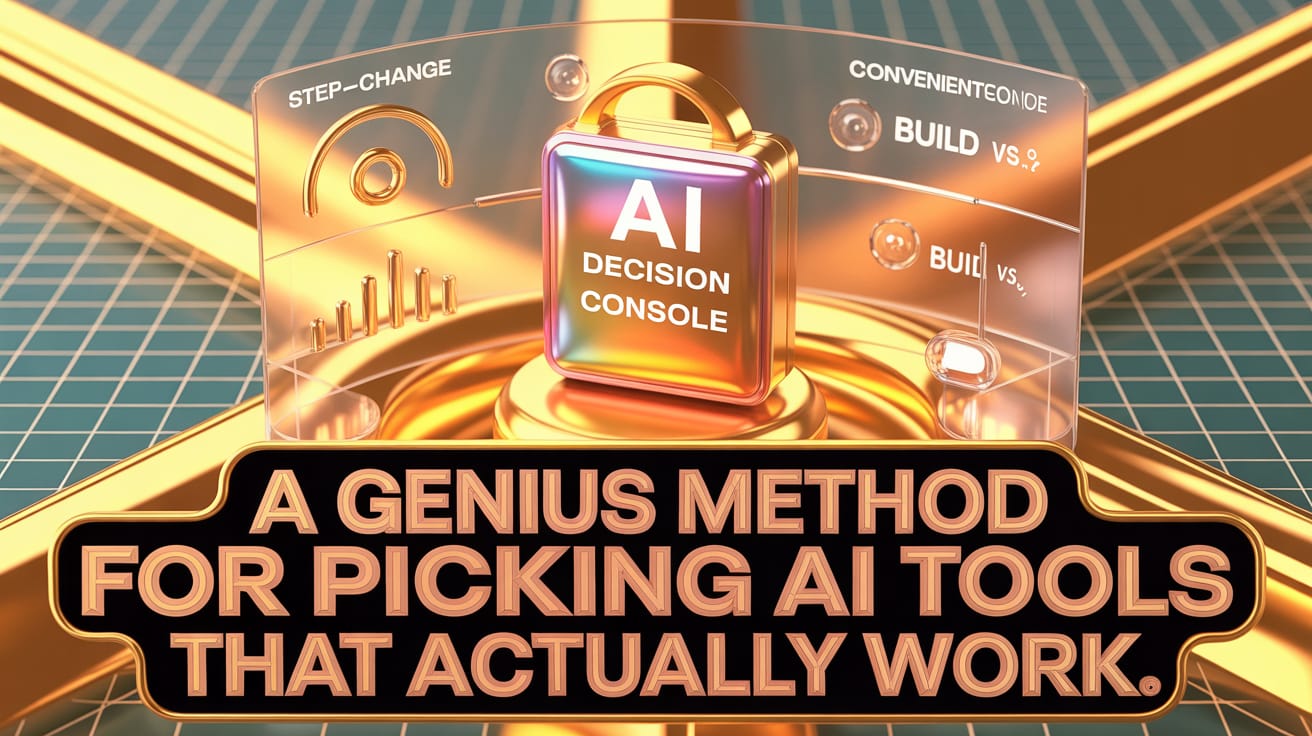
📊 How would you describe your current relationship with AI tools? |
Table of Contents
Introduction: The AI Storm And The Paralysis Of Modern Times
Are you feeling "drowned" amidst a flood of AI tool subscriptions? Have you ever had the startling realization that you're paying for 10 different services while only actively using half of them? Every week, it seems, a new "game-changing" tool emerges that everyone on social media insists you "must try."
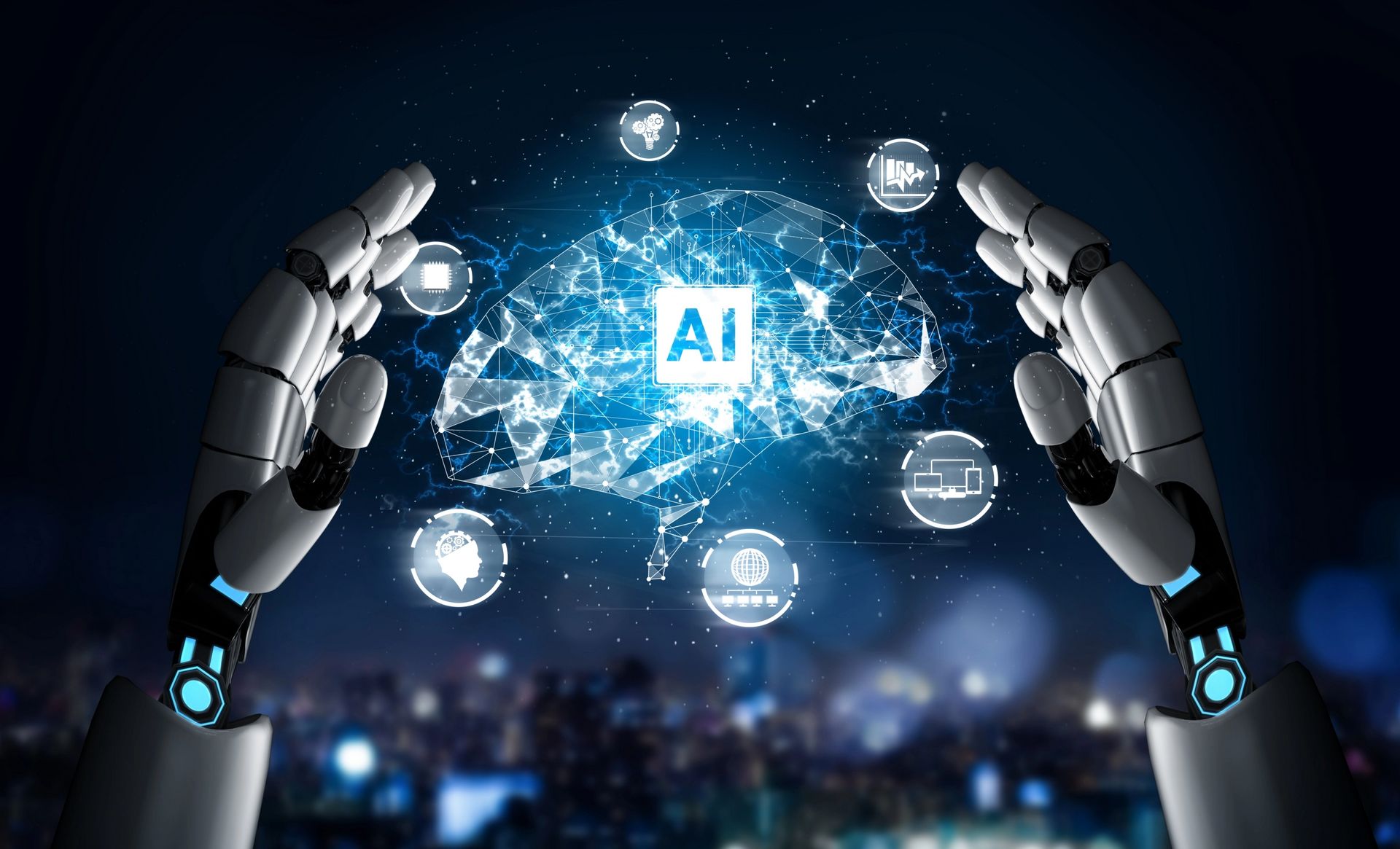
This situation creates two common and equally detrimental problems: either you become an "AI tool hoarder," collecting them like rare trading cards, or you go on a complete "boycott," deciding not to adopt any new tools at all. Both approaches cost you time, money, and, most importantly, precious opportunities to enhance your productivity and creativity.
In this comprehensive guide, we will walk through a proven decision framework that helps you filter out the noise and focus on the tools that genuinely deliver value for your specific needs. By the end, you will know exactly how to assess whether a tool is worth your time, when to test it, and most importantly, when you should just build a solution for yourself.
The Reality Check: Why You Need A Decision Framework
Today's AI tool ecosystem is genuinely overwhelming. There are thousands of applications spanning every category - from design apps like UX Pilot, AI browsers like Comet, to countless others. What makes things worse is the rise of "AI tribalism," where people pick sides between ChatGPT and Claude, or Cursor and another code editor, creating unnecessary ideological wars that help no one.
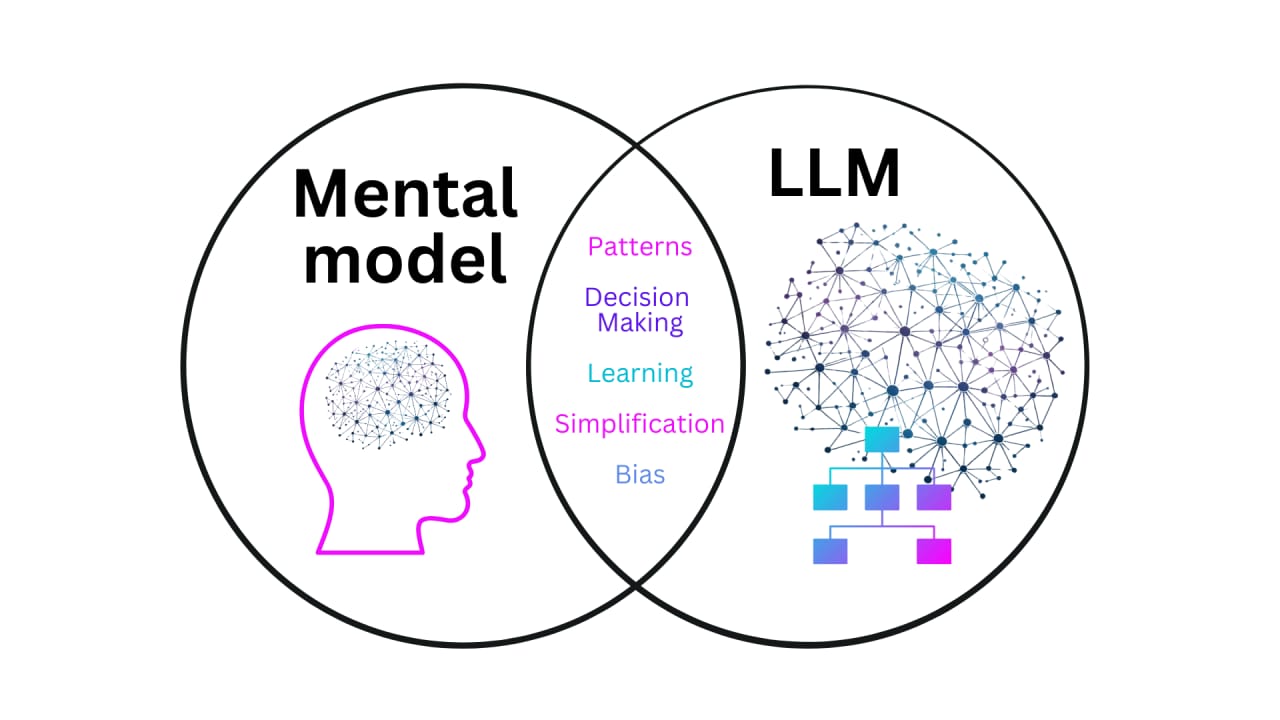
The real problem isn't choosing a side; it's the lack of a proper mental framework to assess whether you truly need a specific tool in your toolkit. Without this framework, you'll easily be swayed by sensational YouTube titles and articles that overuse words like "breakthrough" and "game-changer," ultimately ending up confused, overwhelmed, and financially drained from subscription costs.
The framework we are about to explore isn't a rigid formula but a compass to help you navigate the AI storm. It helps you shift from being a passive reactor to the market to an active, strategic chooser of what's best for you.
Phase 1: The Initial Filter - Identifying Real Step Changes
This is the preliminary assessment, your very first filter. Before you spend even five minutes signing up for a new tool's free trial, ask yourself: "Does this tool introduce any form of step change for the specific work I am trying to accomplish?"
A step change isn't a minor 5-10% improvement. It has to be a qualitative leap forward. Here are four types of step changes to look for:
1. New Capabilities Unlocked
Look for tools that enable you to do things you previously couldn't, or that required highly specialized skills.
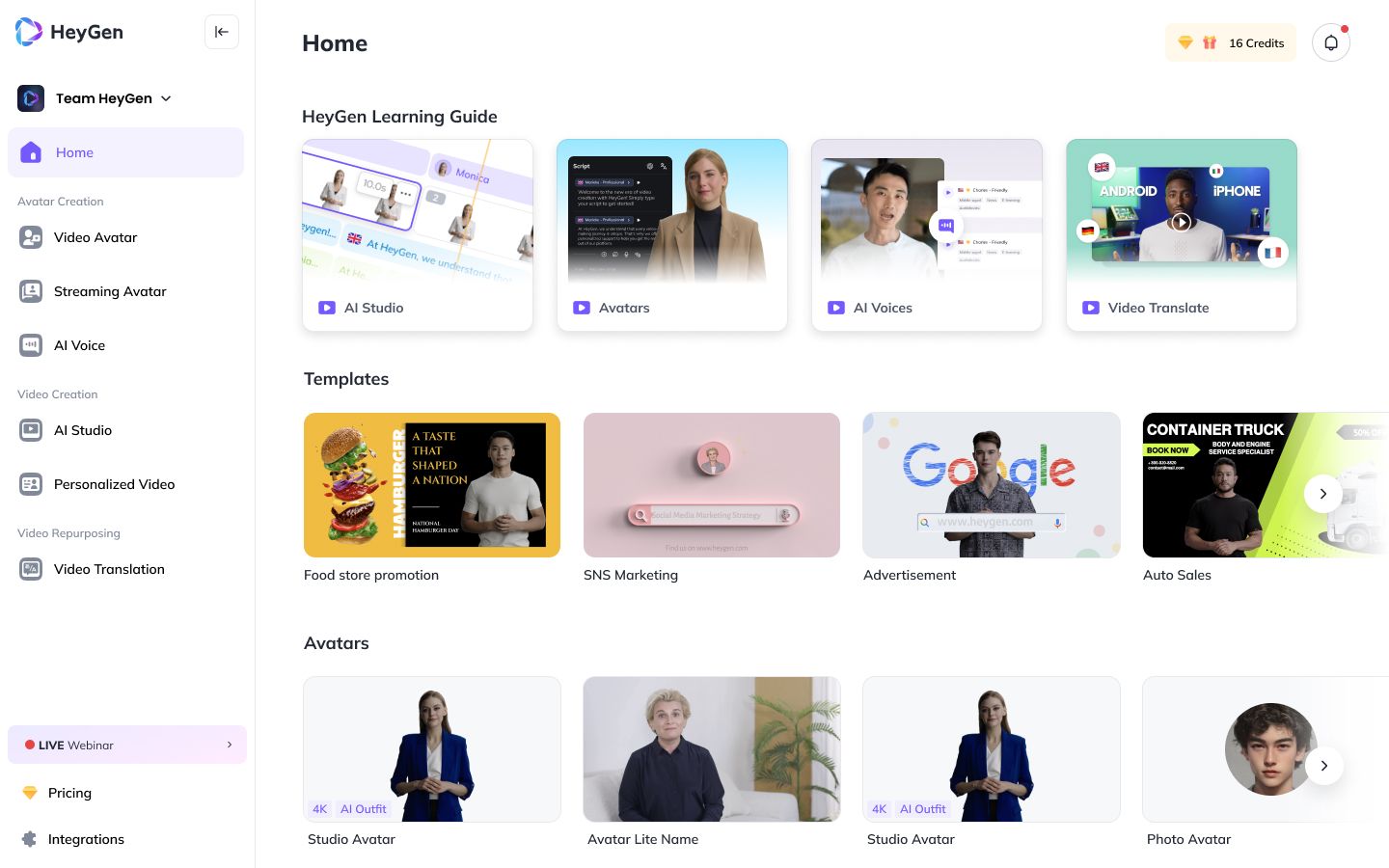
Example: In the past, creating a short product introduction video required a team including a scriptwriter, actor, cameraperson, and video editor. Now, tools like Synthesia or HeyGen allow a single person to create a video with an AI avatar speaking any language, all from a text script. This is a completely new capability unlocked for small businesses and individual marketers.
Another Example: An interior designer can use generative AI image tools like Midjourney to create dozens of conceptual visualizations for a room in minutes, a task that previously could take days to sketch or 3D model.
Learn How to Make AI Work For You!
Transform your AI skills with the AI Fire Academy Premium Plan - FREE for 14 days! Gain instant access to 500+ AI workflows, advanced tutorials, exclusive case studies and unbeatable discounts. No risks, cancel anytime.
2. 10x Improvements
These are tools that aren't just slightly better, but exponentially better. Look for dramatic improvements - whether it's 10x cost savings, 10x token efficiency, or 10x faster performance with the same input.
Example: A data analytics team typically spends a week processing, cleaning, and visualizing a large dataset. A new AI tool emerges that can interpret natural language ("Show me the sales trends for product X in Q3 by region") and return a complete chart in minutes. This is a 10x (or even 100x) improvement in speed.

Another Example: New language models with extremely large context windows allow you to upload an entire book or a repository of documents and ask questions about it. Compared to having to break the text into small chunks as before, this is a 10x improvement in convenience and depth of analysis.

3. Category Creation
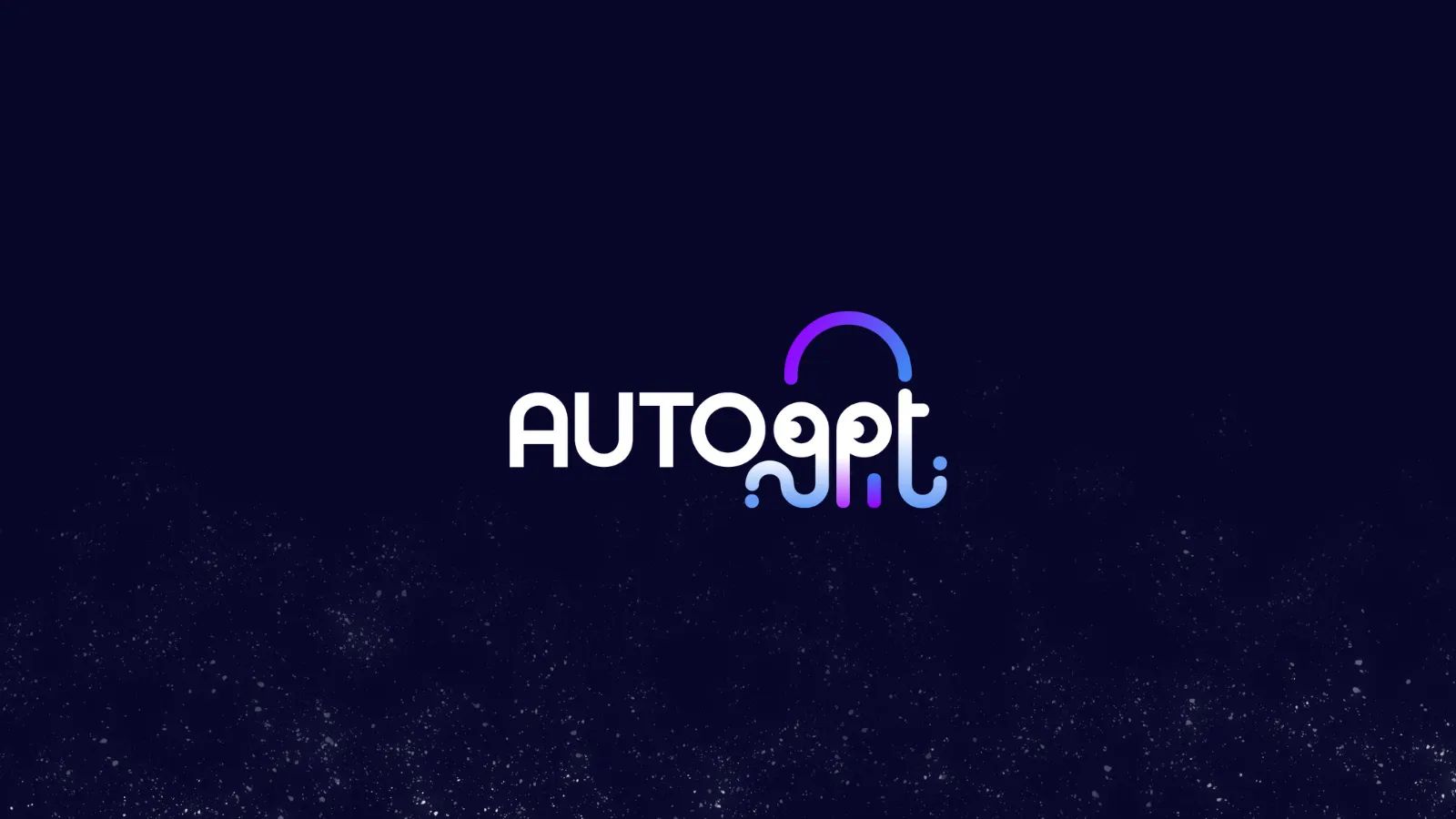
Identify the pioneering tools that create entirely new markets. Before 2024, the "vibe coding" market - where you could enter a natural language prompt and get a working app in 5 minutes - hardly existed. The first tools to achieve this created a profitable new category that everyone now wants to compete in.
Example: The emergence of autonomous "AI Agents." Tools like AutoGPT and its more commercialized successors have created a new category: AI agents that can plan, execute steps, and achieve complex goals without constant human intervention.
4. Paradigm Shifts
These tools fundamentally change who can accomplish certain tasks. They democratize skills and entire industries. "Vibe coding" tools are a prime example: they allow a plumber, a welder, or anyone without a coding background to build simple applications using natural language. This is a complete paradigm shift in software development.
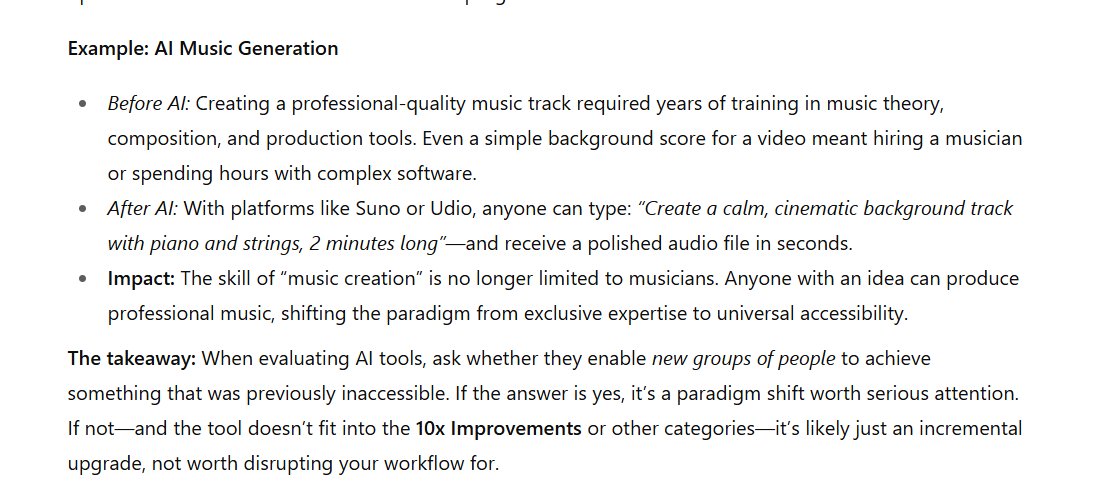
Example: AI music generation platforms allow anyone to create a professional-quality background track for their video without knowing music theory. This has shifted the paradigm from "only musicians can create music" to "anyone with an idea can create music."
This high-level assessment helps you decide whether to investigate further or to skip it entirely. If a tool doesn't fall into any of these four categories, it's likely just an incremental improvement and not worth disrupting your current workflow for.
Phase 2: The Build Vs. Buy Assessment
If a tool passes the filter in Phase 1, the next step is to determine whether you should buy (subscribe) or if you could build a similar solution yourself. This phase involves three fundamental questions:
1. Can I Build This Myself?
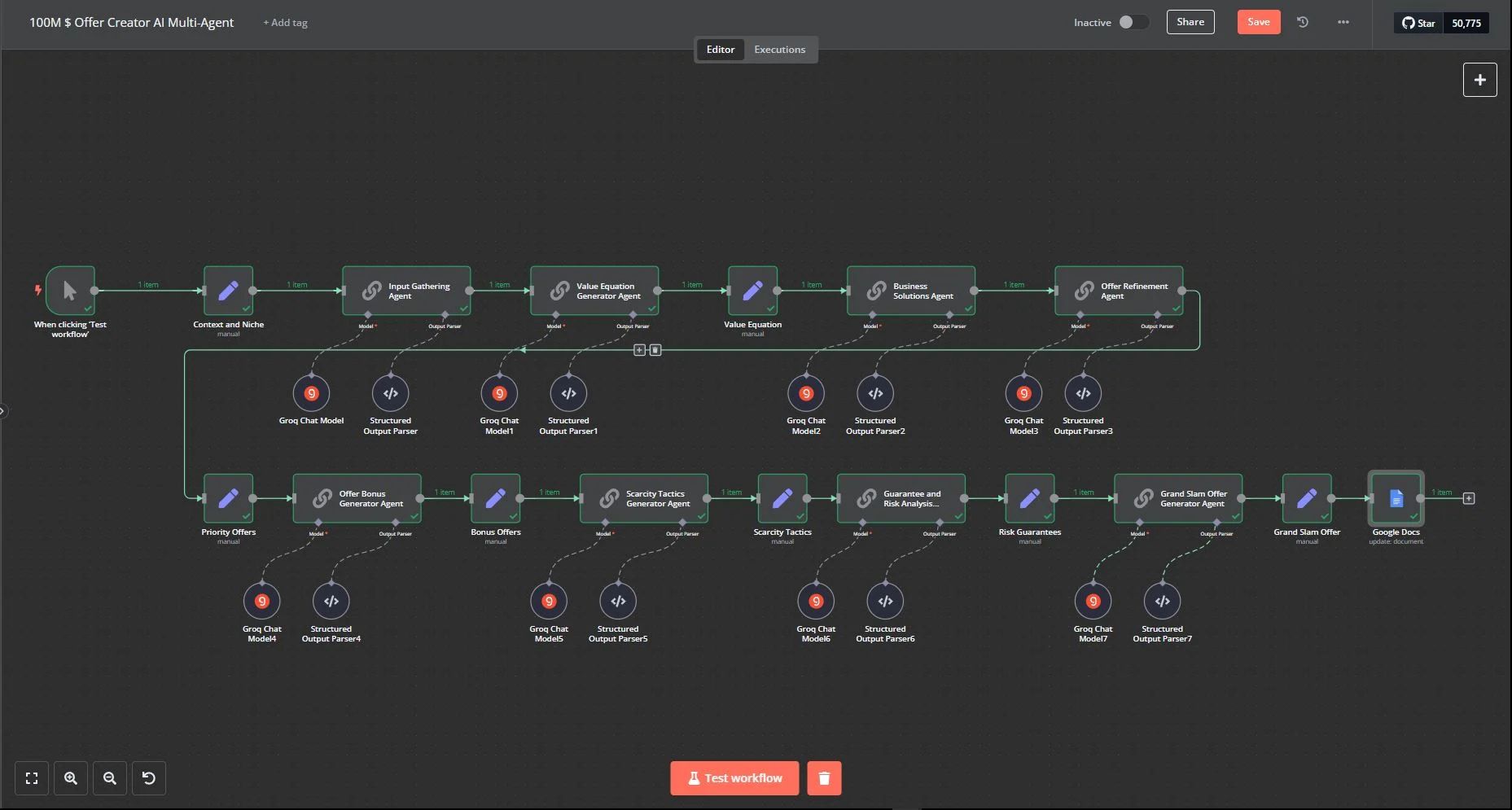
This is the most important question. In today's tech landscape, "building" doesn't necessarily mean writing thousands of lines of code from scratch. With powerful automation tools like n8n and its text-to-workflow feature, or the upcoming similar capabilities from Make, you can often go from an idea to a drafted workflow in just 1-2 hours. You can then hook it up to a front-end that was "vibe-coded" using natural language.
Many SaaS (Software as a Service) applications are well-built products where the hardest part wasn't the technology, but validating that a market for the product existed. Once you see a tool has proven the concept, and assuming it has no "secret sauce" (which we'll cover next), paying a monthly fee might not be worth it if you can rebuild it for less and customize it to your exact needs.
However, consider the "Hidden Costs of Building It Yourself":
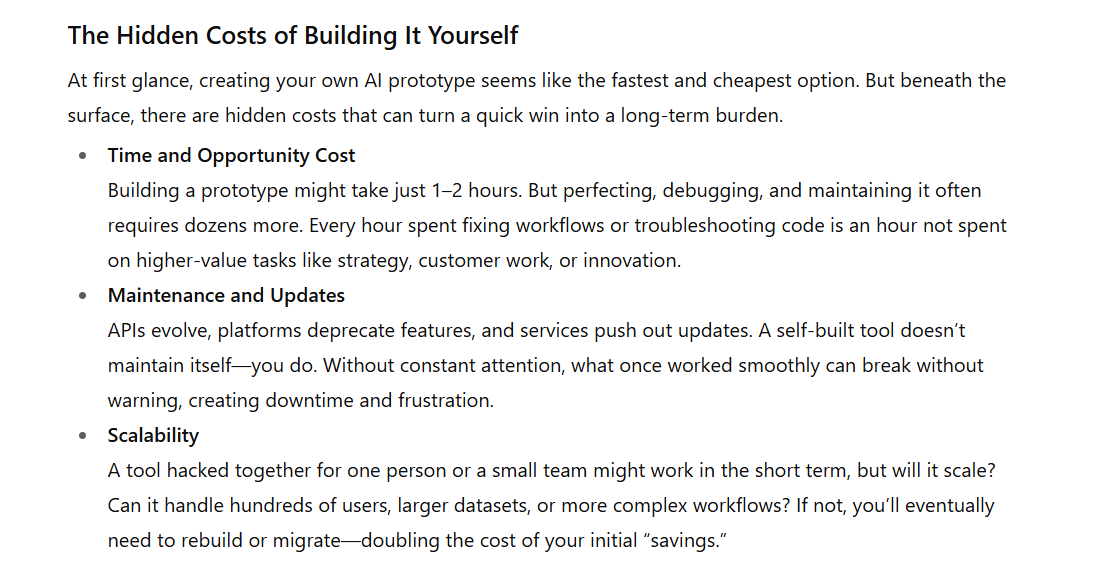
Time and Opportunity Cost: It might take 1-2 hours for a prototype, but how many hours to perfect, debug, and maintain it? Could that time be spent on higher-value tasks?
Maintenance and Updates: APIs change, services get updated. Your self-built solution requires constant attention.
Scalability: Can your solution handle a larger number of users or more data in the future?
2. Do They Have A "Secret Sauce"?

"Sauce" comes in various forms, and you'll get an intuitive feel after examining whether the product has a real competitive advantage or an "economic moat." This is the element that makes their product difficult to perfectly replicate. We will dive deep into what constitutes real "secret sauce" in Phase 3.
3. Can The Big Players Replicate This?
Consider whether established, reputable companies (those unlikely to disappear in 6-12 months) can easily create the same tool or experience.
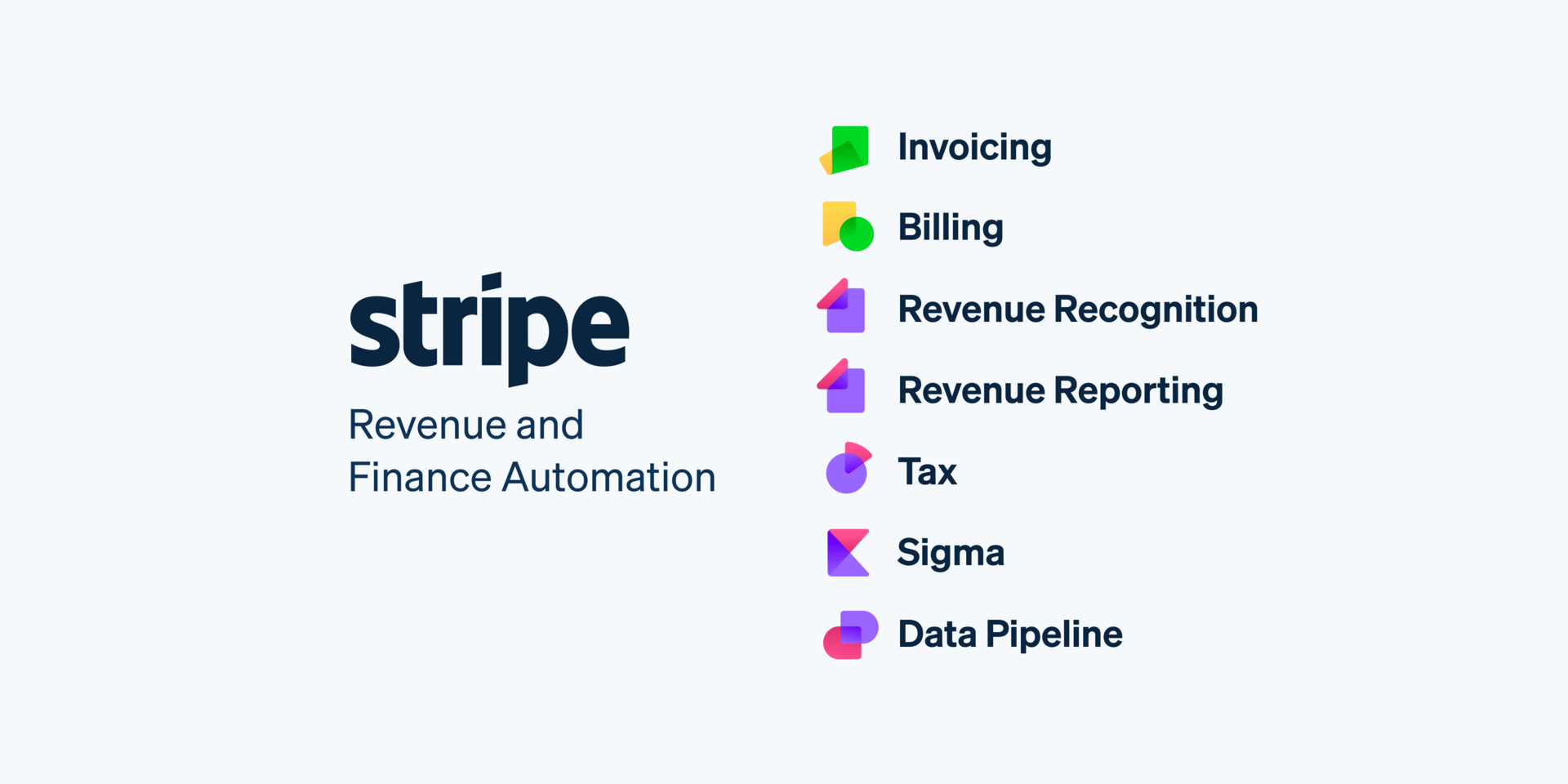
A Classic Example: Two years ago, companies building white-labeled custom GPTs were considered revolutionary. Now, you can "vibe-code" that entire experience, add a Stripe payment gateway and a Supabase backend with relative ease. Even more concerning - if the use case is popular enough, ChatGPT itself might just build it in as a native feature.
The Reality Of Vendor Risk:
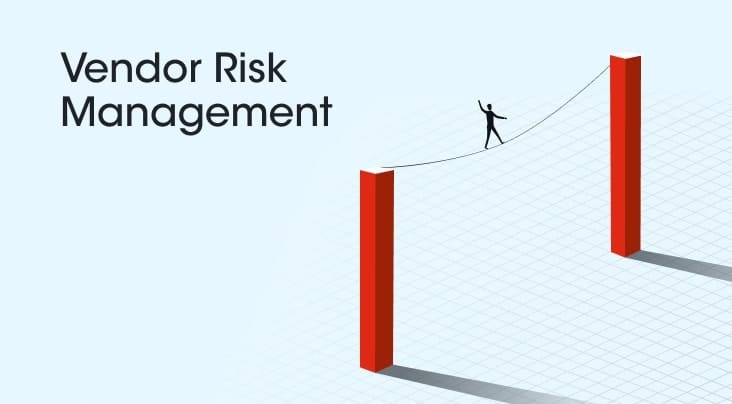
We constantly see major updates from platform providers (like OpenAI, Google, Microsoft) that make hundreds of startups obsolete overnight. Depending on a startup that could disappear creates a serious risk. Imagine your entire team's workflow being paralyzed for weeks while you have to rebuild or find an alternative. This is a real business risk that needs careful consideration.
Phase 3: Deep Dive - What Counts As Real "Secret Sauce"?
A real competitive advantage (an economic moat) isn't just a pretty interface. It's a durable barrier that makes it hard for competitors to keep up. Here are several forms of valuable "secret sauce":
1. Complex Workflow Orchestration
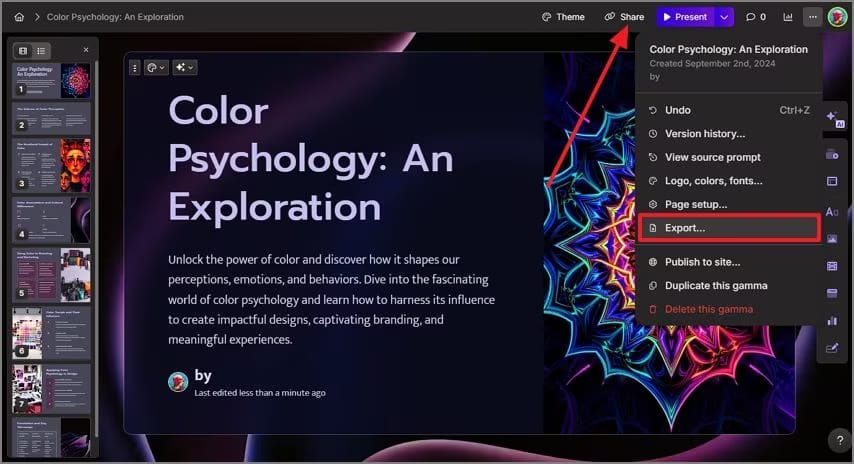
Some companies are exceptionally good at orchestrating sophisticated and intricate workflows behind the scenes. Take Gamma as an example - they excel at creating AI-powered slide presentations. While you could theoretically build similar workflows in n8n, perfectly replicating the positioning, latency handling, design layouts, and font choices could take significantly more time to reverse-engineer than simply paying for their product. Furthermore, very few large incumbents are obsessed with solving this specific problem.
2. Security Infrastructure
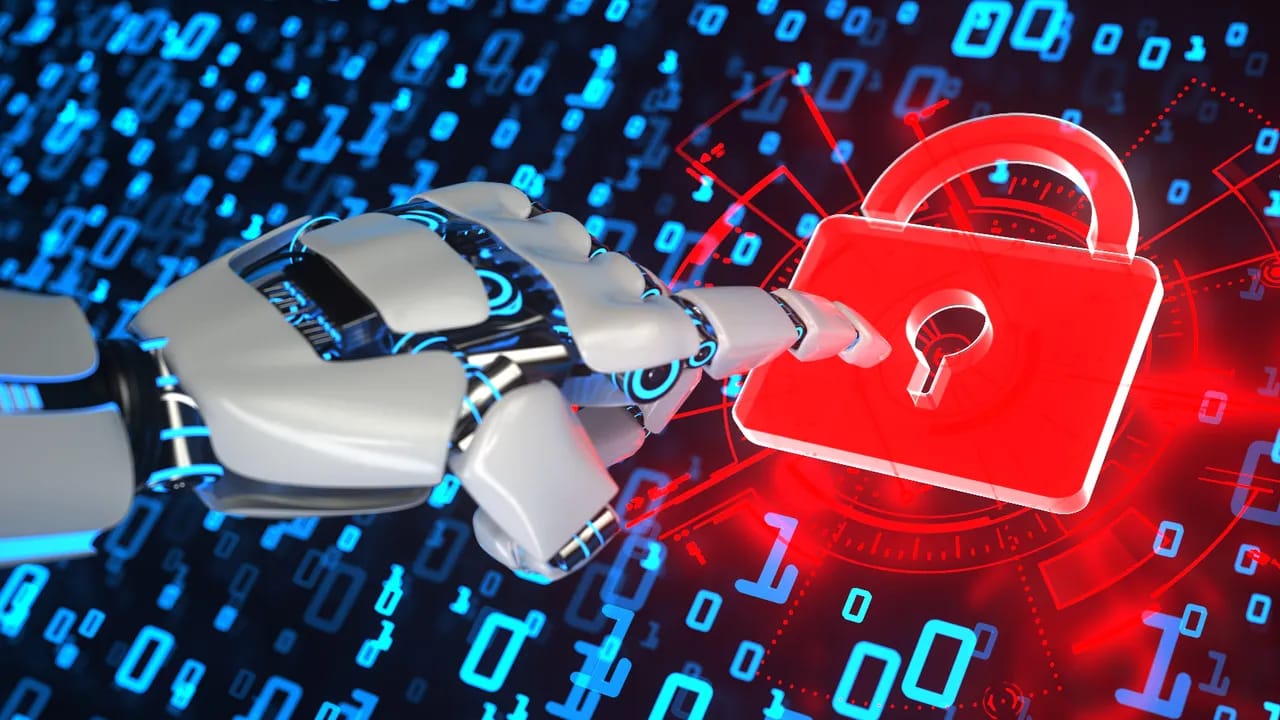
Companies that handle tasks in a highly secure manner save you from building complex security infrastructure yourself. This is especially critical for businesses that handle sensitive customer data. Using a platform that is compliant with standards like SOC 2 or GDPR provides time savings, cost savings, and peace of mind.
3. Proprietary Data
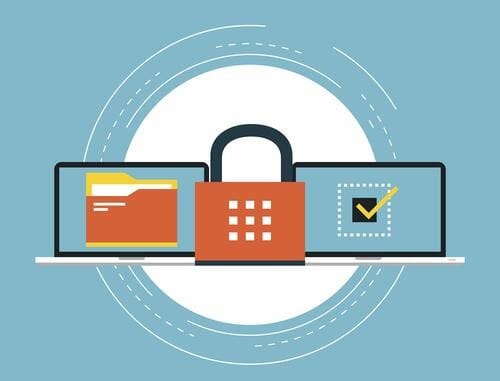
This is one of the strongest moats. If a company has spent years collecting and refining a unique, proprietary dataset that no one else has, the AI models trained on that data will have an inherent advantage. Competitors cannot easily replicate the output because they don't have the same "ingredients."
4. Network Effects
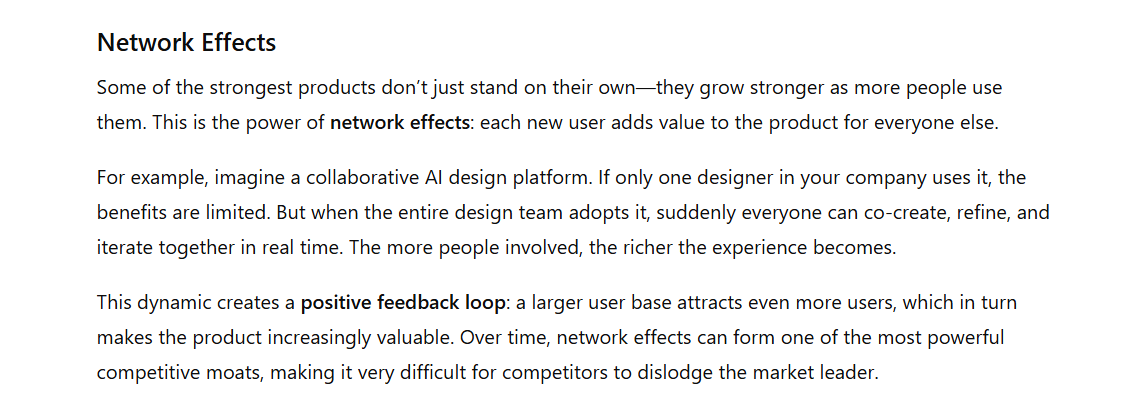
A product with network effects becomes more valuable as more people use it. For example, a collaborative AI design tool where team members can jointly refine designs becomes much more useful when your entire team is on board. New users are attracted by the existing user base, creating a positive feedback loop of growth.
5. Elegant Implementation
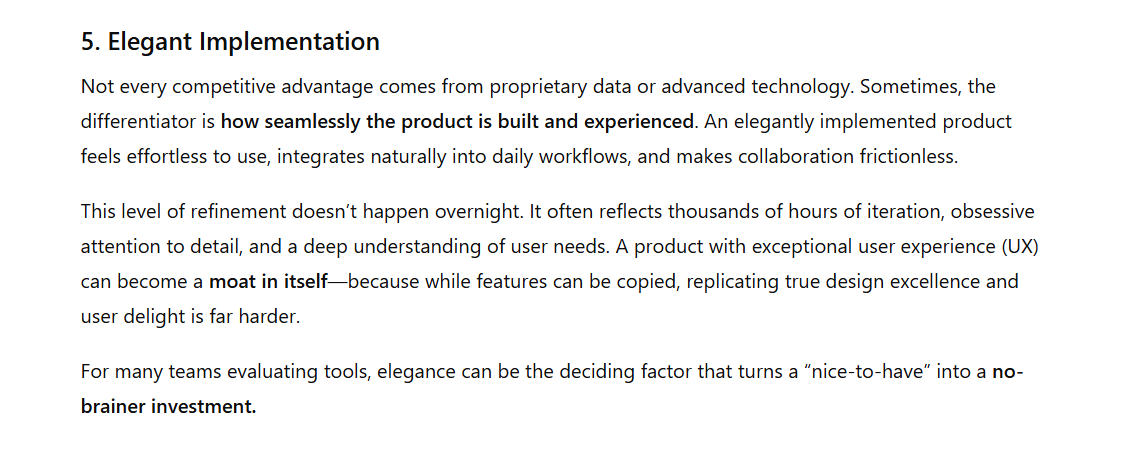
Sometimes, the competitive advantage is simply that the product is implemented so smoothly, so elegantly, and is so conducive to team sharing that it becomes a no-brainer investment. An exceptional user experience (UX) can be a moat because it requires a deep understanding of the user and thousands of hours of refinement.
6. Economies Of Scale
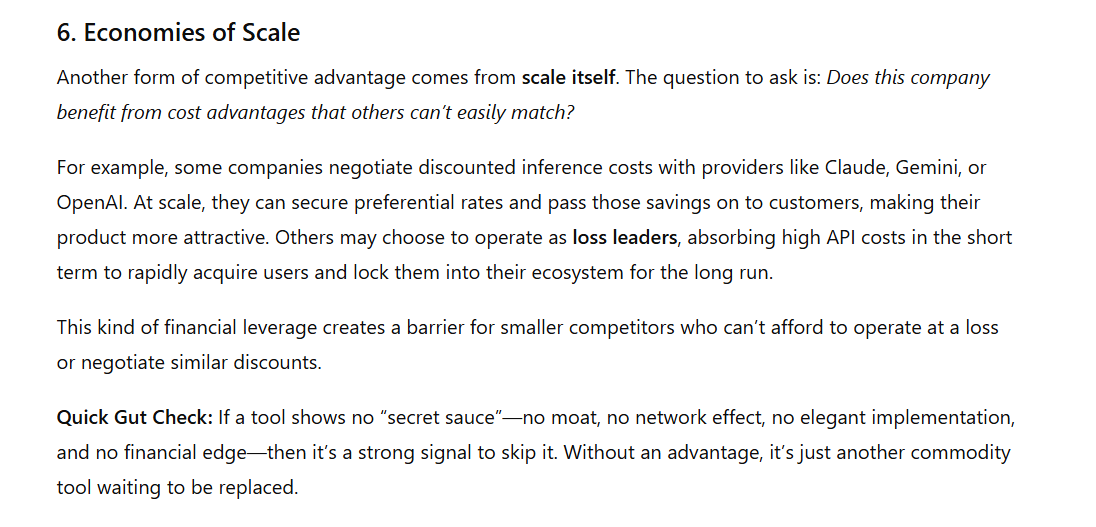
This is a crucial factor. Does the company have access to discounted inference costs for language models? At a large scale, many companies negotiate deals with Claude, Gemini, or OpenAI for preferential rates that they can then pass on to their customers. Or, they are so focused on customer acquisition that they become loss leaders, absorbing the API costs to make you a sticky customer on their platform.
A Quick Gut Check: If a tool has no sauce whatsoever, no moat, and no financial advantage to using it - that's an instant sign to skip it.
Phase 4: The "Vibe-Code" Test
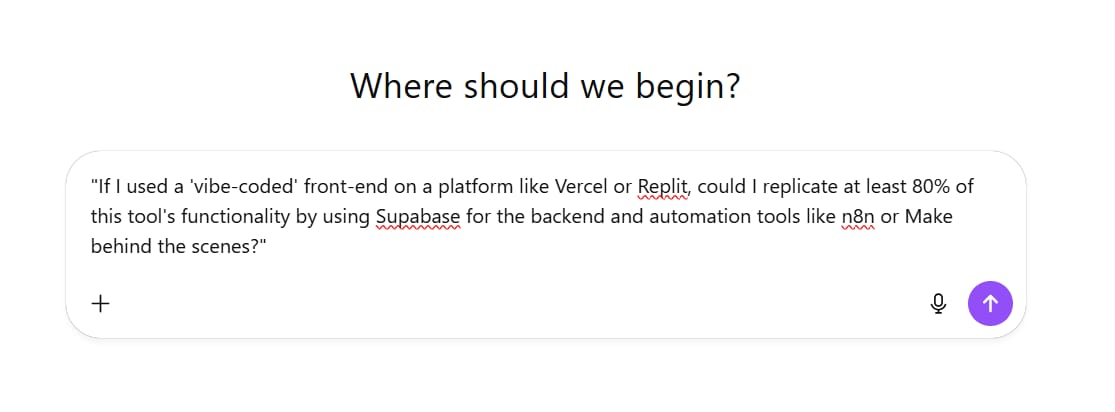
This phase tests whether you can realistically replicate the tool yourself. Ask: "If I used a 'vibe-coded' front-end on a platform like Vercel or Replit, could I replicate at least 80% of this tool's functionality by using Supabase for the backend and automation tools like n8n or Make behind the scenes?"
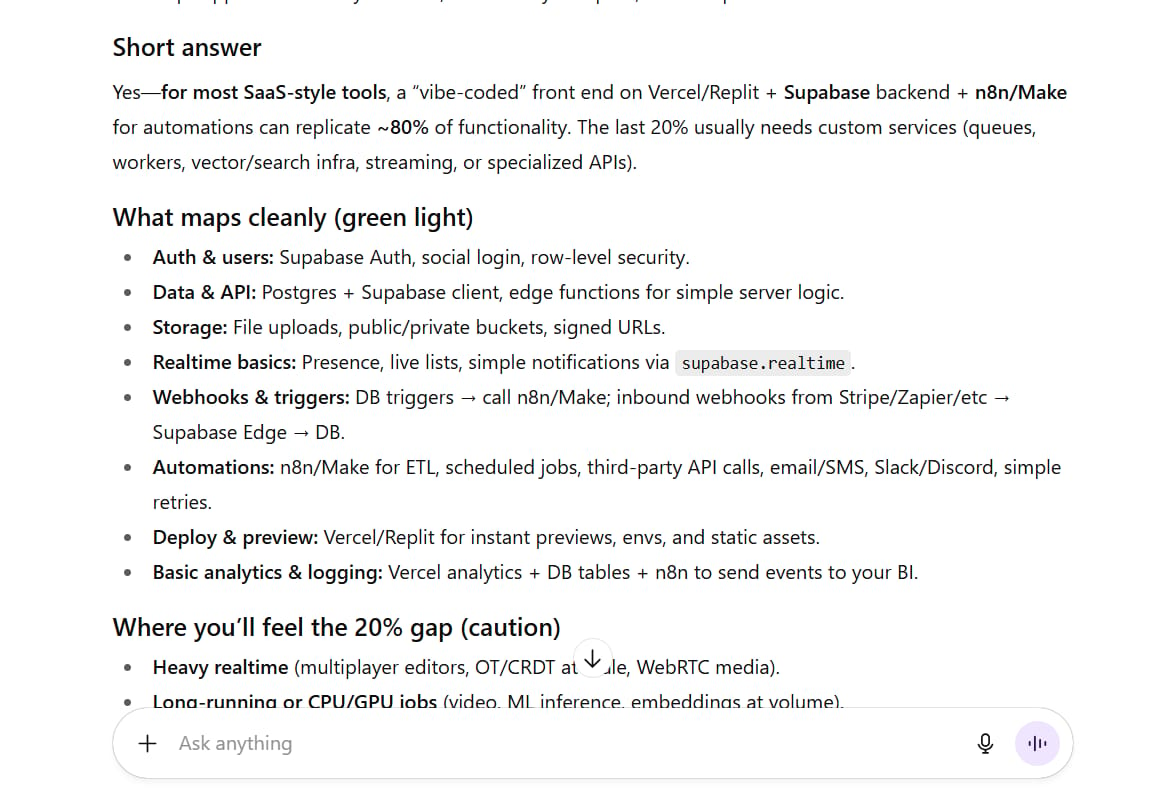
Let's imagine a scenario: you find a new SaaS tool that generates social media posts from a blog post URL.
Frontend: You could use a tool like Carrd or a simple framework to create a webpage with a URL input field and a button.

Backend Logic: When a user clicks the button, a function (e.g., a Supabase edge function) is triggered.

Workflow: This function sends the URL to an n8n workflow. This workflow would:

If you can easily map out the steps to rebuild it, then it might be well worth your time to create a version tailored to your specific business needs.
However, always remember the economics. If generating 100,000 images yourself would cost you $50,000 in direct API costs, but a platform offers it for $24/month due to its economies of scale, the math is clear.
The Decision Point: If a tool is too complex to build AND you don't get economies of scale advantages by doing it yourself, then it makes more sense to buy versus build.
Phase 5: The Momentum Test
This phase examines a company's momentum and its capability to ship product updates. A great tool today could become useless tomorrow if it's not maintained. We need to assess the provider's "vitality."
Key Momentum Signals to Evaluate:
1. Shipping Velocity
Does the company consistently release new features and improvements? Check their blog, Discord channel, or changelog.
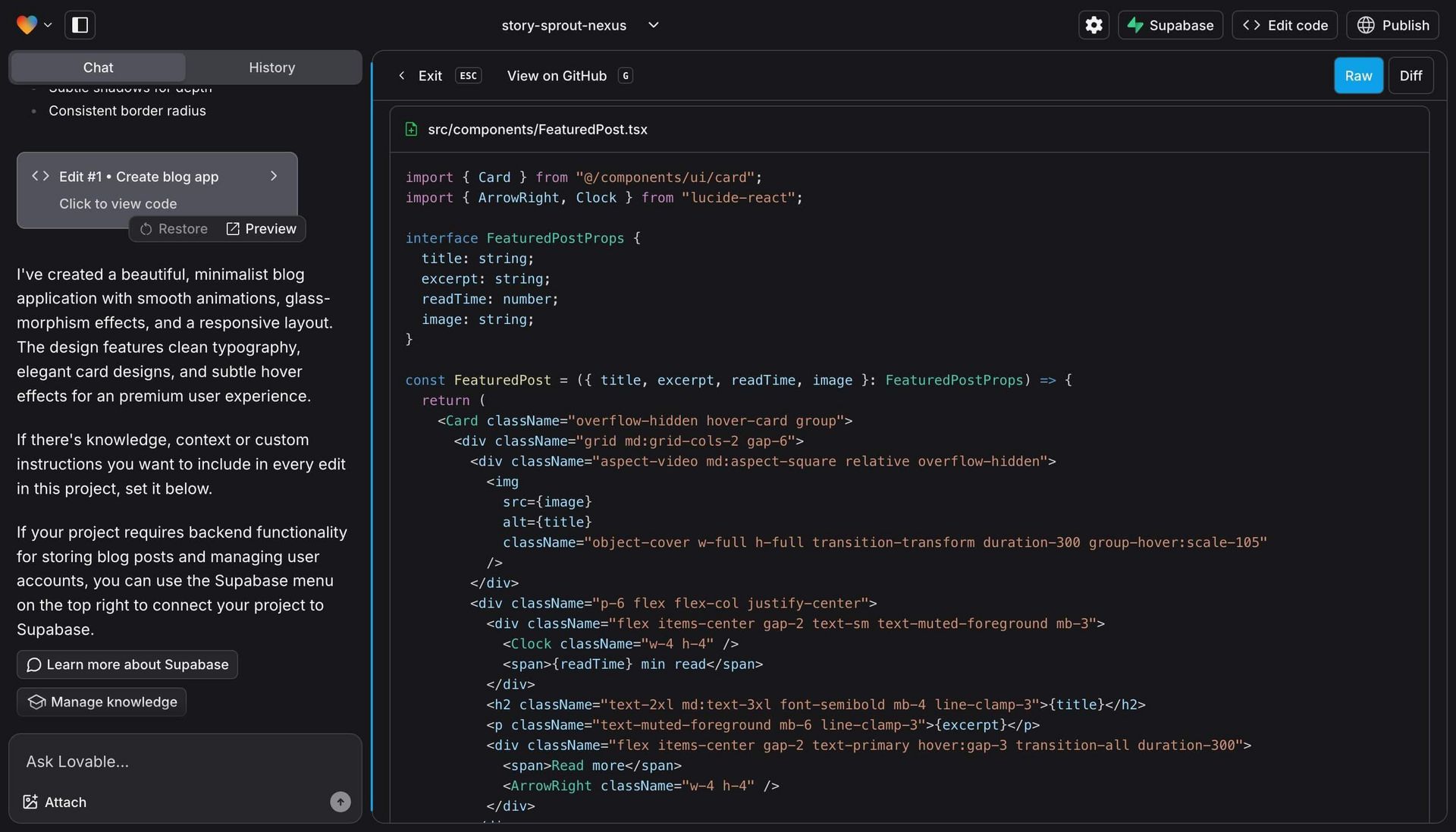
Green Flag: A weekly or bi-weekly feature release schedule. A clear and public product roadmap. Lovable is a great case study - starting as an unknown, their weekly shipping schedule put them on the map and into the community consciousness.
Red Flag: Products that are built once, have one big launch, and then go silent usually die quickly. A blog that hasn't been updated in 6 months is a very bad sign.
2. Free Tier Generosity
How much can you test for free?
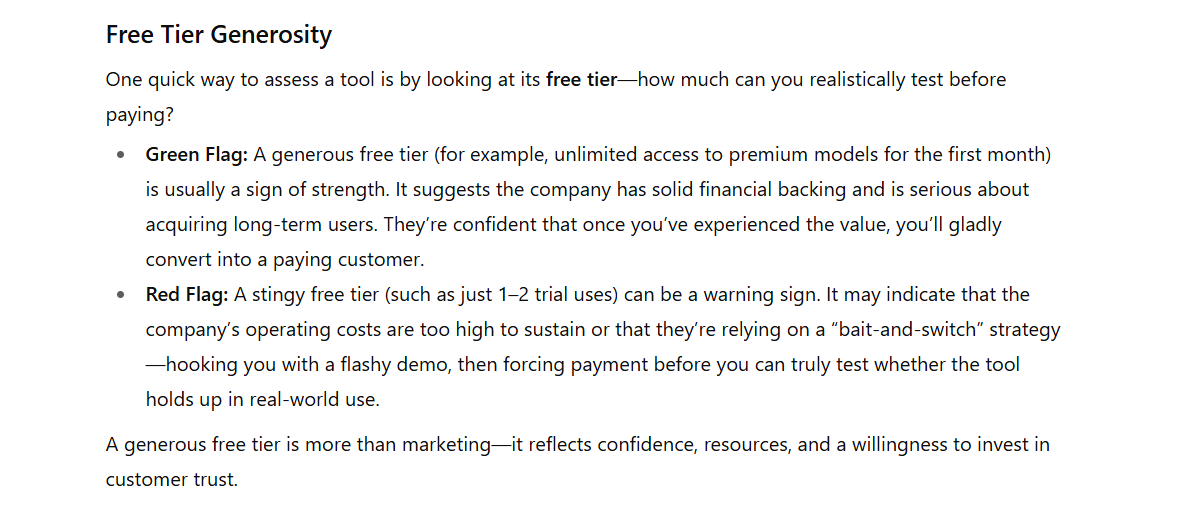
Green Flag: Generous free tiers (e.g., unlimited access to expensive models for a period) indicate that the company has solid financial backing and is serious about customer acquisition. They are confident that once you've experienced enough value, you'll be willing to pay.
Red Flag: Very limited free tiers (only 1-2 uses) might suggest their operating costs are too high to sustain, or they are trying to force a purchase after a couple of good initial experiences that might not hold up in production.
3. Platform Play Clarity
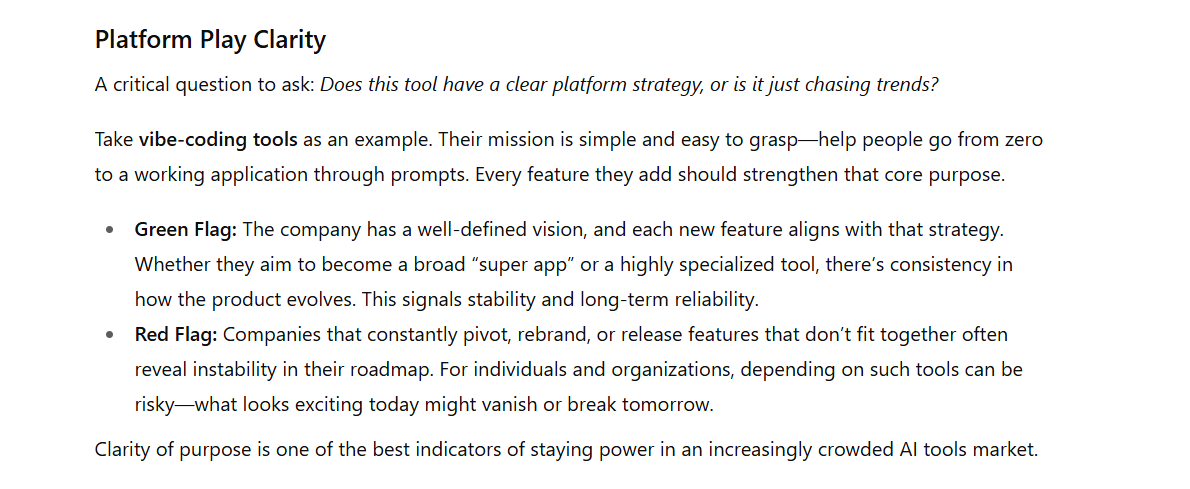
Does the tool have a clear platform strategy? Vibe-coding tools have a straightforward goal: help people go from zero to a working application via prompts.
Green Flag: The company has a clear vision, and every new feature serves to strengthen that vision, whether it's to become a super app or a deep, specialized tool.
Red Flag: Companies that constantly pivot without a clear identity often signal instability in their product roadmap. Whether you're an individual or an organization, avoid depending on companies that lack staying power.
4. The Lindy Effect
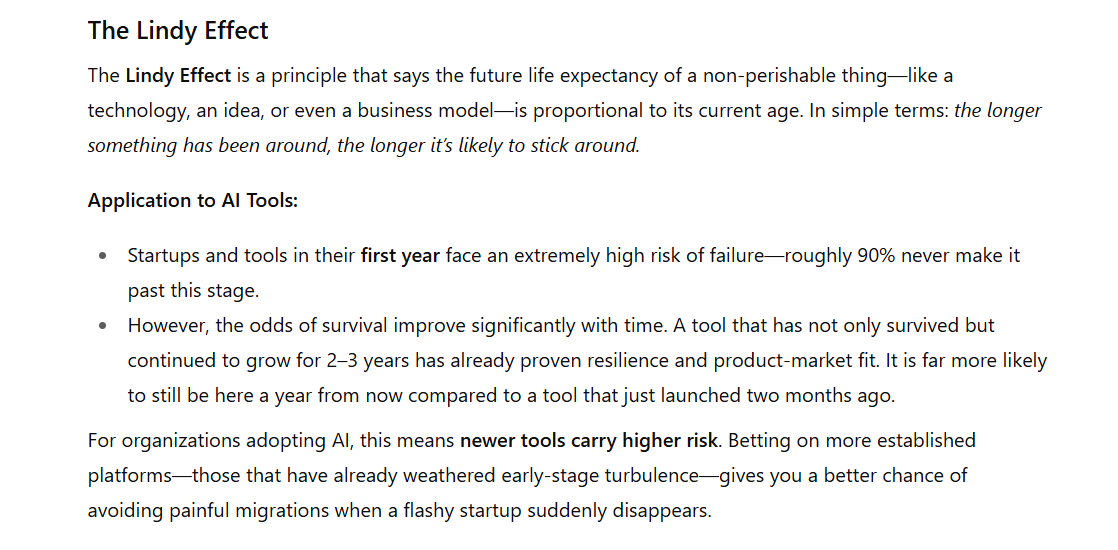
The Lindy Effect suggests that the future life expectancy of a non-perishable thing - like a technology or an idea - is proportional to its current age. Simply put: the longer something has existed, the more likely it is to continue existing.
Application: First-year businesses have a very high failure rate (~90%), but their probability of survival increases each year. Apply this thinking to AI tools. Newer tools carry a higher risk of disappearing. A tool that has survived and grown for 2-3 years is more likely to be around in the next 12 months than a tool that launched 2 months ago.
Phase 6: The Depth Ladder - Specialists Vs. Generalists
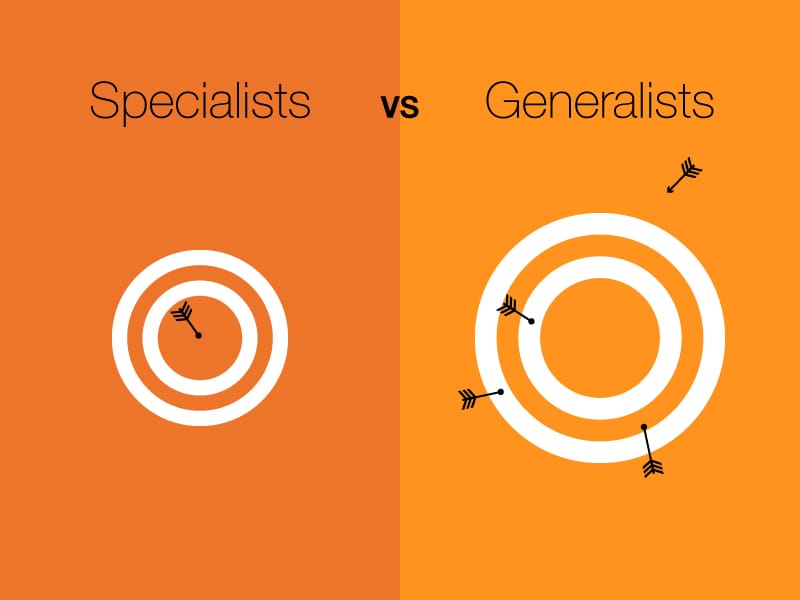
This final phase asks: Is this a specialized tool or a broad, general-purpose one? Generalist tools need more scrutiny as they might lack focus, becoming a "jack of all trades, master of none."
Imagine you need a tool: a Swiss Army knife (a generalist tool) is very handy for everyday, miscellaneous tasks. But if you're a heart surgeon, you need a set of specialized scalpels (specialist tools).
Key Questions:
Is the breadth of this tool deep enough for my specific needs?
What level of depth do I actually require?
Assessment By Usage Level:
Casual Use:

Who: Students, content creators, office workers needing to solve quick tasks.
Needs: Summarizing text, writing emails, creating simple illustrative images, brainstorming ideas.
Choice: Super apps and all-in-one tools work fine for these basic needs. The free version of ChatGPT, Gemini, or other multi-feature tools are often sufficient.
Professional Use:
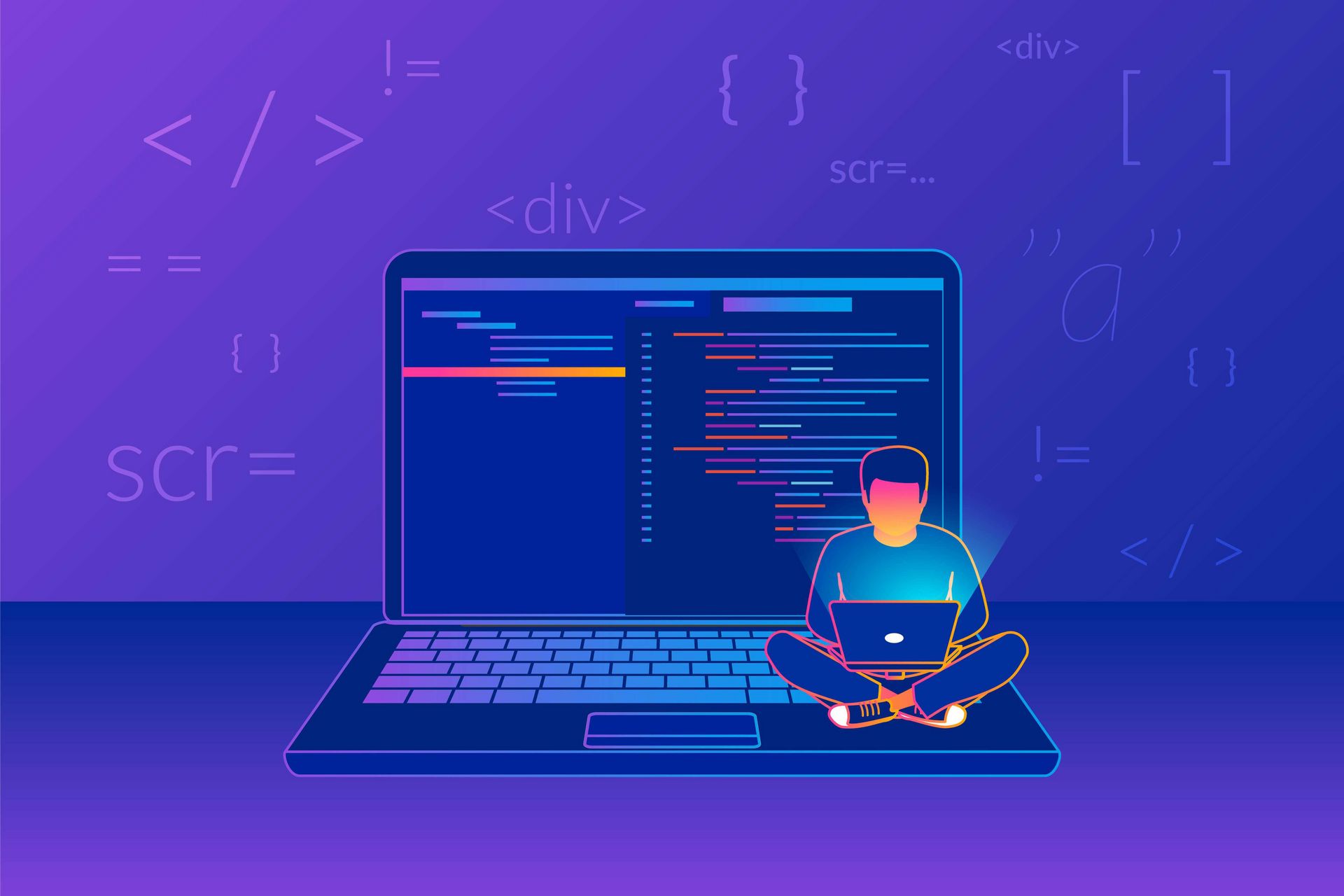
Who: Developers, marketers, designers, data analysts.
Needs: Building applications, automating complex marketing funnels, creating product designs, analyzing large datasets.
Choice: Opt for well-funded, focused tools like Lovable, Bolt, and Replit with substantial backing and personnel. Avoid betting on "Tool X" that might seem easier but has only been around for 3 months with an unknown 12-month survival probability.
Expert Level:

Who: AI researchers, machine learning engineers, security specialists.
Needs: Fine-tuning language models, auditing source code for security vulnerabilities, minimizing hallucinations in complex models.
Choice: Specialized tools like Cursor (for developers) focus intensely on their core users. They are constantly improving code reviews, security audits, and proper code generation. Despite the challenges in achieving excellence, the money and community behind these products provide confidence that the time spent learning them won't quickly become obsolete.
Betting on Durability: Always bet on tools that you believe will exist 6-12 months from now, or have the funding to pivot if technological breakthroughs occur.
The Final Decision Matrix: Your Complete Framework
Summarizing everything into actionable decision criteria:
When To Adopt (All Must Be True):
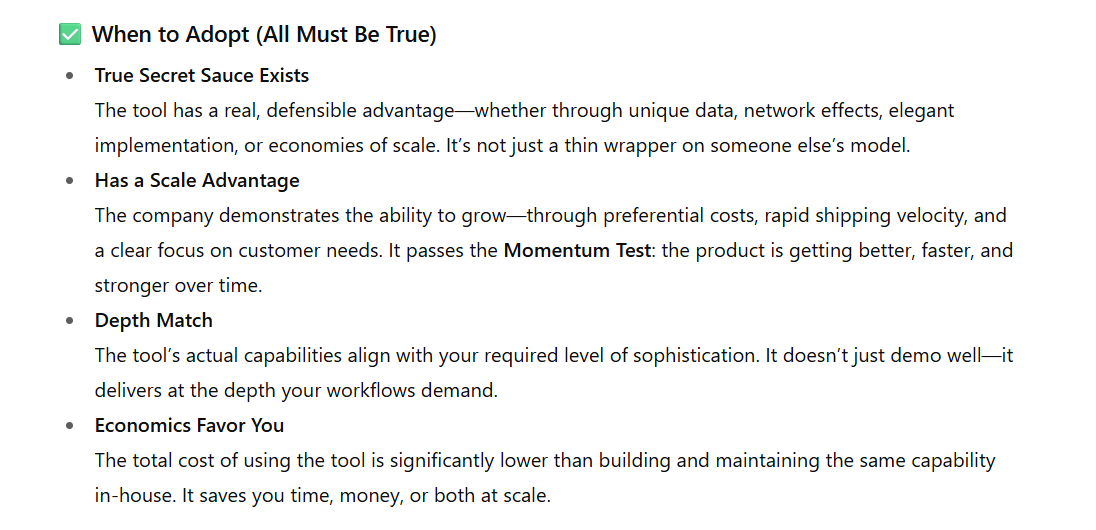
True Secret Sauce Exists: It has real competitive advantages, not just a simple "wrapper" application.
Has a Scale Advantage: It demonstrates economies of scale, shipping velocity, and customer focus (passes the "Momentum Test").
Depth Match: The tool's capabilities match your required level of depth.
Economics Favor You: It is significantly more cost-effective than building it yourself.
When To Build Instead:
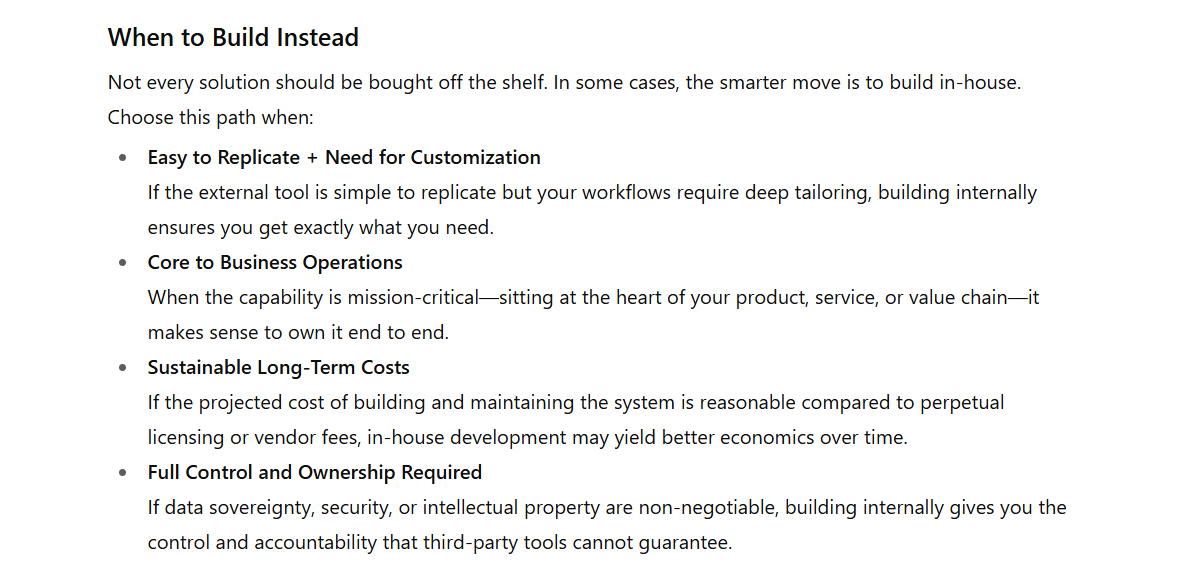
It's easy to replicate AND you need deep customization.
It is core to your business operations.
The long-term cost of building and maintaining is reasonable.
You want complete control and ownership of the data and process.
When To Ignore:
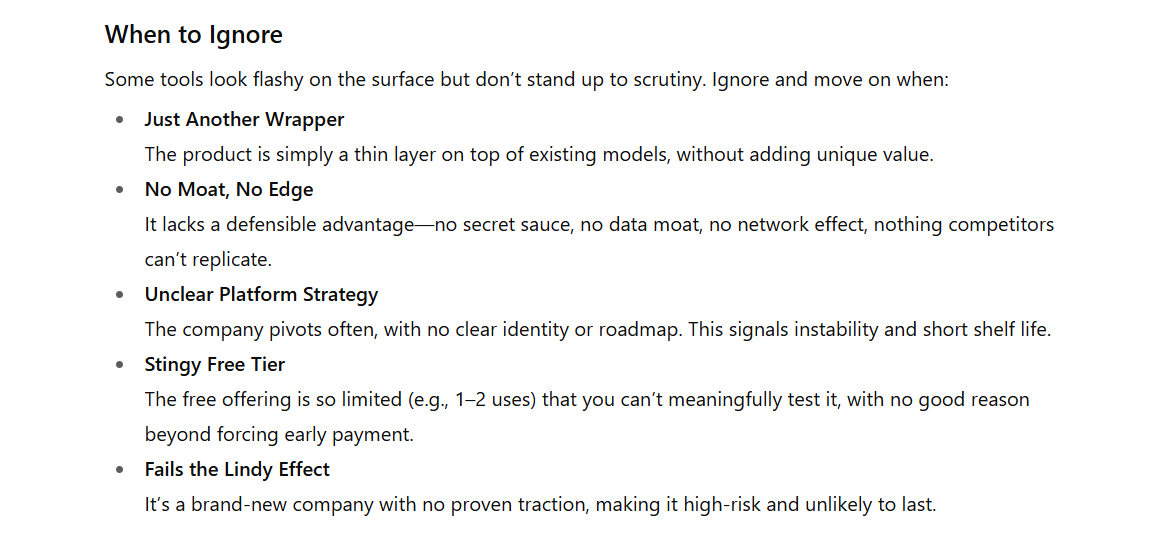
It's just another "wrapper" with no unique value.
It has no moat or competitive advantage.
It has an unclear platform strategy or is constantly pivoting.
The free tier is very limited without justification.
It's a new company with a high risk of disappearing (fails the Lindy Effect).
The Wrapper Warning
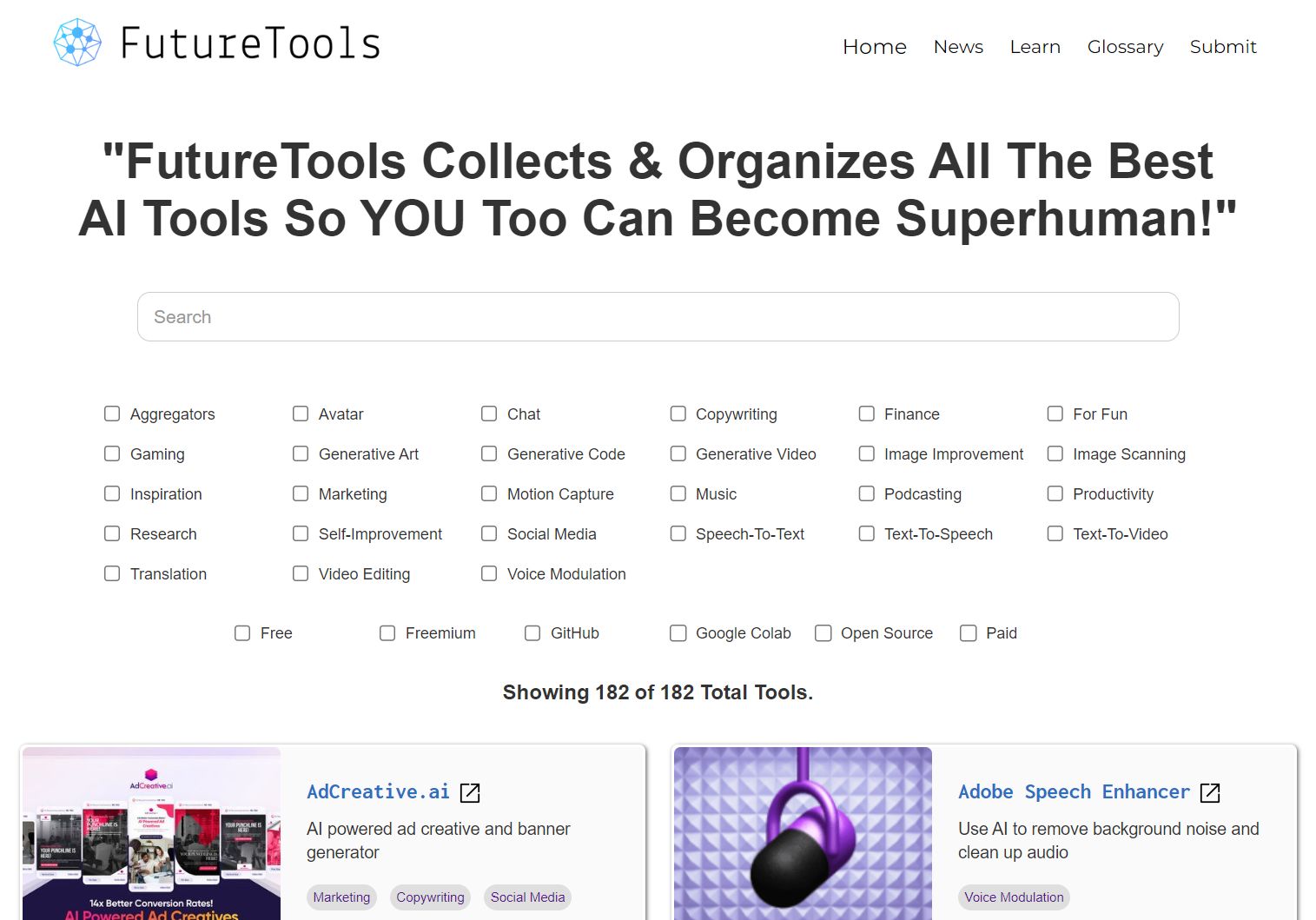
One easy way to spot tools to ignore is to browse aggregator platforms like Future Tools. You'll see endless companies you've never heard of. Many are quickly "vibe-coded" applications that will disappear over time. In this landscape, having discipline and a decision framework is more important than ever.
Conclusion: Building Your Personal AI Ecosystem
The explosion of AI tools creates both opportunities and traps. Without a proper framework, you'll either become a tool hoarder or miss out on genuinely useful innovations. This six-phase approach - from spotting step changes to assessing depth needs - gives you the mental model to make quick, profitable decisions.
Remember: the goal isn't to use the newest tools or pick sides in tribal wars. It's to build a personal AI ecosystem that serves your specific needs efficiently and cost-effectively. Focus on tools with real competitive advantages, clear staying power, and economics that favor you over DIY approaches.
Start applying this framework today. Before subscribing to that next "game-changing" tool, run it through these phases. Your time, money, and sanity will thank you for the discipline.
The key is having a systematic approach rather than making reactive decisions based on hype. With this framework, you'll cut through the noise and build a sustainable, effective AI toolkit that truly serves your goals.
If you are interested in other topics and how AI is transforming different aspects of our lives or even in making money using AI with more detailed, step-by-step guidance, you can find our other articles here:
How useful was this AI tool article for you? 💻Let us know how this article on AI tools helped with your work or learning. Your feedback helps us improve! |
Reply